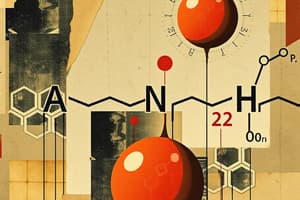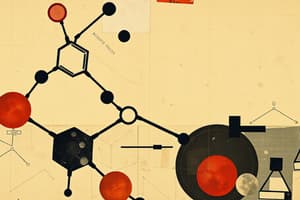Podcast
Questions and Answers
Which statement accurately describes the regioselectivity of hydrohalogenation reactions involving alkenes?
Which statement accurately describes the regioselectivity of hydrohalogenation reactions involving alkenes?
- Halogen addition is random and yields a mixture of products.
- Halogen addition occurs at the more substituted carbon of the double bond, following Markovnikov's rule. (correct)
- Halogen addition occurs at the least substituted carbon of the double bond.
- Halogen addition always follows anti-Markovnikov's rule.
What type of intermediate is formed in carbocation-forming addition reactions, potentially leading to rearrangements?
What type of intermediate is formed in carbocation-forming addition reactions, potentially leading to rearrangements?
- Carbocation (correct)
- Carbanion
- Free radical
- Carbene
In the acid-catalyzed hydration of an alkene, what type of product is formed?
In the acid-catalyzed hydration of an alkene, what type of product is formed?
- Alcohol (correct)
- Alkane
- Ether
- Halohydrin
Which statement correctly describes the stereospecificity of a halogenation reaction of an alkene?
Which statement correctly describes the stereospecificity of a halogenation reaction of an alkene?
What is the product formed when an alkene undergoes a modified halogenation reaction with water (halohydrin formation)?
What is the product formed when an alkene undergoes a modified halogenation reaction with water (halohydrin formation)?
What is the stereochemical outcome of oxymercuration-demercuration reactions?
What is the stereochemical outcome of oxymercuration-demercuration reactions?
In modified oxymercuration-demercuration using an alcohol instead of water, what functional group is introduced?
In modified oxymercuration-demercuration using an alcohol instead of water, what functional group is introduced?
What is the stereochemical outcome of epoxide hydrolysis under acidic conditions?
What is the stereochemical outcome of epoxide hydrolysis under acidic conditions?
What is the stereochemistry of hydrogen addition in catalytic hydrogenation reactions?
What is the stereochemistry of hydrogen addition in catalytic hydrogenation reactions?
According to the hydroboration-oxidation reaction, to which position will the alcohol group add?
According to the hydroboration-oxidation reaction, to which position will the alcohol group add?
What functional group is formed when an alkene undergoes peroxyacid epoxidation?
What functional group is formed when an alkene undergoes peroxyacid epoxidation?
What is the stereochemical outcome of halohydrin epoxidation?
What is the stereochemical outcome of halohydrin epoxidation?
What functional group is produced from the hydroxylation/osmylation of an alkene?
What functional group is produced from the hydroxylation/osmylation of an alkene?
What type of intermediate is involved in the dichlorocarbene addition to an alkene?
What type of intermediate is involved in the dichlorocarbene addition to an alkene?
Which reagent is typically used in the Simmons-Smith reaction to form a cyclopropane?
Which reagent is typically used in the Simmons-Smith reaction to form a cyclopropane?
What products are formed when alkenes undergo reductive ozonolysis?
What products are formed when alkenes undergo reductive ozonolysis?
What type of products result from the oxidative cleavage of diols?
What type of products result from the oxidative cleavage of diols?
According to alkyne formation, what is needed to turn a double bond into a triple bond?
According to alkyne formation, what is needed to turn a double bond into a triple bond?
Predict the major product of the reaction of 1-butyne with 1 equivalent of HBr.
Predict the major product of the reaction of 1-butyne with 1 equivalent of HBr.
What type of product is formed in a base-catalyzed tautomerization?
What type of product is formed in a base-catalyzed tautomerization?
Flashcards
Addition Reaction
Addition Reaction
Reaction that adds two groups across a double bond.
Hydrohalogenation
Hydrohalogenation
Adds H and X (halogen) across a double bond, halogen on more substituted carbon. Carbocation rearrangement possible.
Acid-Catalyzed Hydration
Acid-Catalyzed Hydration
Adds H and OH across a double bond to form an alcohol. Carbocation rearrangement possible.
Modified Acid-Catalyzed Reaction
Modified Acid-Catalyzed Reaction
Signup and view all the flashcards
Halogenation
Halogenation
Signup and view all the flashcards
Modified Halogenation - Halohydrin
Modified Halogenation - Halohydrin
Signup and view all the flashcards
Modified Halohydrin Formation
Modified Halohydrin Formation
Signup and view all the flashcards
Oxymercuration-Demercuration
Oxymercuration-Demercuration
Signup and view all the flashcards
Modified Oxymercuration - Demurcuration
Modified Oxymercuration - Demurcuration
Signup and view all the flashcards
Hydrolysis of Epoxide
Hydrolysis of Epoxide
Signup and view all the flashcards
Catalytic Hydrogenation
Catalytic Hydrogenation
Signup and view all the flashcards
Hydroboration Oxidation
Hydroboration Oxidation
Signup and view all the flashcards
Peroxyacid Epoxidation
Peroxyacid Epoxidation
Signup and view all the flashcards
Halohydrin Epoxidation
Halohydrin Epoxidation
Signup and view all the flashcards
Hydroxylation/Osmylation
Hydroxylation/Osmylation
Signup and view all the flashcards
Dichlorocarbene Addition
Dichlorocarbene Addition
Signup and view all the flashcards
Simmons-Smith Reaction
Simmons-Smith Reaction
Signup and view all the flashcards
Reductive Ozonolysis
Reductive Ozonolysis
Signup and view all the flashcards
Oxidative Cleavage
Oxidative Cleavage
Signup and view all the flashcards
Reduction of Alkynes
Reduction of Alkynes
Signup and view all the flashcards
Study Notes
- These notes cover addition reactions, alkyne reactions, and related mechanisms.
Addition Reactions Overview
- Addition reactions involve adding two groups across a double bond.
- These reactions can form carbocations, potentially leading to rearrangements.
Hydrohalogenation
- Reaction: An alkene reacts with HX (X = Cl, Br, I) in ether.
- Product: An alkyl halide forms with the halogen attached to the more substituted carbon (Markovnikov selectivity).
- Regioselectivity: Follows Markovnikov's rule.
- Stereospecificity: Not applicable (N/A).
Acid-Catalyzed Hydration
- Reaction: An alkene reacts with H₂SO₄ and H₂O.
- Product: An alcohol.
- Regioselectivity: Markovnikov.
- Stereospecificity: N/A.
Modified Acid-Catalyzed Reaction
- Reaction: An alkene reacts with H₂SO₄ and HOCH₃.
- Product: An ether.
- Regioselectivity: Markovnikov.
- Stereospecificity: N/A.
- Carbocation rearrangements can occur in the above reactions that form carbocations (hydride, methyl, or ring shifts).
Anti-Addition Reactions Overview
- Anti-addition reactions add two groups on opposite sides of the double bond without carbocation rearrangement.
Halogenation
- Reaction: An alkene reacts with X₂ (X = Cl, Br) in CH₂Cl₂.
- Product: A vicinal dihalide forms with anti-stereochemistry.
- Regioselectivity: Markovnikov.
- Stereospecificity: Anti.
Modified Halogenation - Halohydrin Formation
- Reaction: An alkene reacts with X₂ (X = Cl, Br) and H₂O.
- Product: A halohydrin (halogen and alcohol) forms with anti-stereochemistry.
- Regioselectivity: Markovnikov.
- Stereospecificity: Anti.
Modified Halohydrin Formation (Alkene to Halogen + Ether)
- Reaction: Alkene reacts with Br₂ and CH₃OH.
- Product: Haloether.
- Regioselectivity: Markovnikov.
- Stereospecificity: Anti.
- Only displays stereochemistry if an achiral center is made.
Oxymercuration-Demercuration
- Reaction: Alkene reacts with 1) Hg(OAc)₂, H₂O and 2) NaBH₄.
- Product: Alcohol
- Regioselectivity: Markovnikov
- Stereospecificity: Anti
- Enantiomer products may also form.
Modified Oxymercuration-Demercuration (Ether Formation)
- Reaction: Alkene reacts with 1) Hg(OAc)₂, EtOH and 2) NaBH₄.
- Product: Ether
- Regioselectivity: Markovnikov
- Stereospecificity: Anti
Hydrolysis of Epoxide
- Reaction: Epoxide reacts with H₃O⁺.
- Product: Trans-diol.
- Regioselectivity: Occurs under acidic conditions.
- Stereospecificity: Trans.
Syn Addition Reactions
- Syn addition reactions add groups to a double bond on the same side.
Catalytic Hydrogenation
- Reaction: Addition of H to double bonds in syn. Not arene rings.
- Reaction: Alkene reacts with H₂.
- Product: Alkane
- Regioselectivity: Not applicable (N/A).
- Stereospecificity: Syn.
Hydroboration-Oxidation
- Reaction: Alkene reacts with 1) BH₃, THF and 2) H₂O₂,-OH.
- Product: Alcohol, added to the least substituted side
- Regioselectivity: Anti-Markovnikov.
- Stereospecificity: Syn.
Peroxyacid Epoxidation
- Reaction: Forms Epoxide -- 3-member ring with oxygen.
- Product: Epoxide
- Regioselectivity: N/A
- Stereospecificity: Syn
Halohydrin Epoxidation
- Reaction: Forms Epoxide with halogen & strong base.
- Reagents: 1. Cl₂, H₂O, or 2. NaOH
- Byproduct: H₂O + NaCl (if using NaOH)
- Product: Epoxide
- Regloselectivity: N/A
- Stereospecificity: Syn
Hydroxylation (Osmylation)
- Reaction: Alkene to Syn-diols
- Product: Syn diol
- Regioselectivity: N/A
- Stereospecificity: Syn
- Reagents: 1. OsO₄, Pyr 2. NaHSO₃, H₂O
Dichlorocarbene Addition
- Product: Dichloro cyclopropane
- Regioselectivity: N/A.
- Stereospecificity: Syn.
- Attacks a carbene (:CCl₂) to an alkene.
Simmons-Smith Reaction
- Reaction: Cyclopropane formation
- Reagents: CH₂I₂, ZN(Cu), ether
- Product: cyclopropane
- Regioselectivity: N/A
- Stereospecificity: Syn
Simmons-Smith Extension
- Details of the mechanism aren't needed, except how to get to carbenoid (ICH₂-ZnI).
- Carbenoid acts as :CH₂.
- (CH₂I₂ + Zn(Cu) --- ICH₂-ZnI(Carbenoid)
Oxidative Cleavage of Alkenes
- Splits the double bond in two.
Reductive Ozonolysis
- Reaction: Split the double bond, to form a carbonyl group
- Reagents: 1. O₃ 2. Zn, or H+ DMS
- Product; Carbonyl
- Regioselectivity: N/A
- Stereospecificity: N/A
- If 0 H = Ketone
- If 1 H = Aldehyde
- If 2H = Formaldehyde.
Oxidative Cleavage
- Reactions: Forms Carbonyl Groups
- Product:
- KHnO₄, H₃O⁺ --Ketone : OH
- Carboxylic Acid or -: IH
- CO₂ : 2H
- Regioselectivity = N/A
- Stereospecificity = N/A
Oxidative Cleavage of the Diol
- Product - Form carbonyl Groups from the Diol Reagents: HIO₄ , H₂O, THF
- If OH = Ketone
- IH= Aldehyde
- 2H= Formaldehyde Requires to know the intermediate
Alkyne Reactions (Chapter 9)
- Focuses on reactions involving triple bonds
Alkyne Formation
- Reaction: Turns double bond to to triple bond
- Reagents: 1. Br₂, Cl₂Cl₂ 2. 2 eq. KOH
- Product: Alkyne
- Regioselectivity: N/A
- Stereospecificity: N/A
Hydrohalogenation
- Reaction: Addition of 1 or 2 halogens, two diff. products possible
- Reg: HX, ether
- X or H = Cl/BT
- Products: 1 eq = vinyl halide
1 eq - Mark
-
Stereospe: Anti
-
Transition State that share the H to avoid #
-
2 eq = same as above , continue with vinyl halide = germinal dihalide
Halogenation
- Reaction: Additions of 2 to 4 halogens.
- Leg: -
- Product of vicinal and dihalide
** Alcohol Addition to the Alkyne**
- Results in enol formation; this undergoes Tautomerization, which converts an enol into Ketone or Aldehyde.
** Acid -Catalyzed Tautomerization**
- reaction: converts in enol into a ketone/ Aldehyde
- Regioselevtivity: N/A
- Stereospecificity: N/A
Addition of an Alcohol to an Internal Alkyne
- Reaction: H₂O, H₂SO₄ or H₂SO₄
Mercury Catalyzed Hydration: needs catalyst
- R: H₂O, H₂SO₄ , HgSO₄
- Regioselectivity: Mark
- Stereospecficity: N/A
Hydroboration-Oxidation (Alkyne)
- Don't need to know Mechanism
- Regioselectivity: Anti-Mark
- Stereospecificity: N/A
Reduction of Alkynes: Can go from triple bond to double or triple to single bond.
Catalytic Hydrogenation - Alkyne to an Alkane
- Regiospecificity: Anti Stereoselevtivity: N/A Palc
DISSOLVING METAL REDUCTION
- Product: Alkene
- Reagents: Na, NH₂ (1) Regiospecificity: N/A
- Stereoselectivity" Trans only internal alkynes , not terminal
Lindlars Reduction: produces cis-alkene
- Reagents: Lindlars catalyst.
- Products: cis- alkane Oxidation + Chain Extension Alkynes : Cut/ Add/ attach to the chain.
31. Oxidative Ozonolysis
- Reagents:
- O₃, (-78 *degree C)
- Products: 0 Terminal Hydrogen: Carboxylic Acia Terminal Hydrogen = CO₂
32. Acetylide Alkylation: Chain extention.
- Reagents:: 1. Na NH₂ , NH₃ (1), Br
Studying That Suits You
Use AI to generate personalized quizzes and flashcards to suit your learning preferences.




